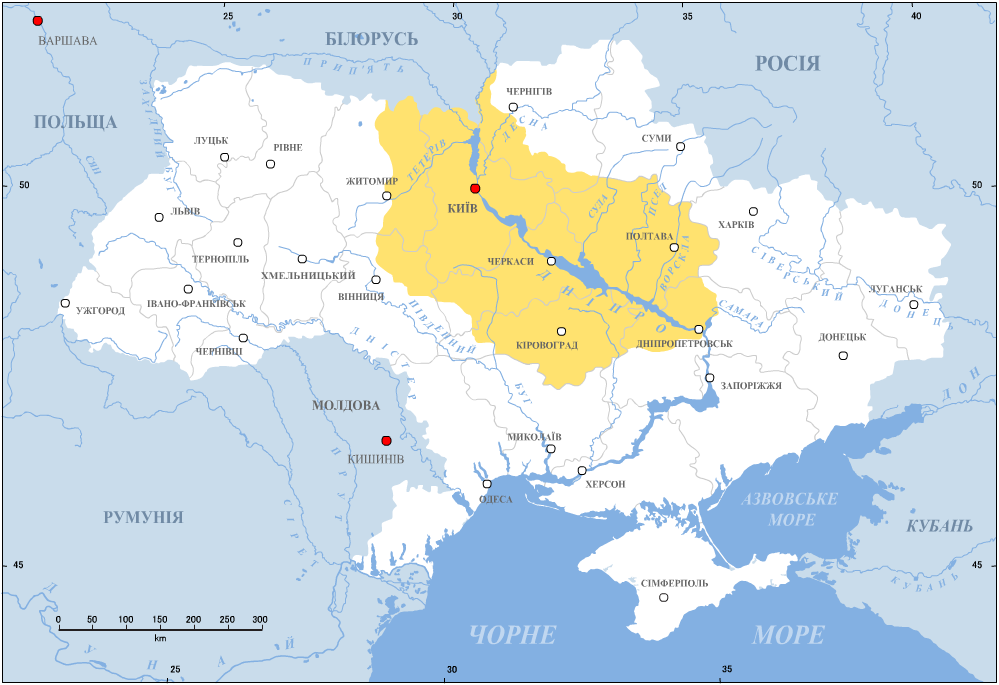Dnieper Ukraine on:
[Wikipedia]
[Google]
[Amazon]
 The term Dnieper Ukraine
(), usually refers to territory on either side of the middle course of the Dnieper River. The Ukrainian name derives from ''nad‑'' (prefix: "above, over") + ''Dnipró'' ("Dnieper") + ''‑shchyna'' (suffix denoting a geographic region). Historically, this region is tightly entwined with the history of
The term Dnieper Ukraine
(), usually refers to territory on either side of the middle course of the Dnieper River. The Ukrainian name derives from ''nad‑'' (prefix: "above, over") + ''Dnipró'' ("Dnieper") + ''‑shchyna'' (suffix denoting a geographic region). Historically, this region is tightly entwined with the history of
Dnieper Ukraine
Encyclopedia of History of Ukraine. {{Coord, 49.32 , 32.74 , display=title Historical regions in Ukraine
 The term Dnieper Ukraine
(), usually refers to territory on either side of the middle course of the Dnieper River. The Ukrainian name derives from ''nad‑'' (prefix: "above, over") + ''Dnipró'' ("Dnieper") + ''‑shchyna'' (suffix denoting a geographic region). Historically, this region is tightly entwined with the history of
The term Dnieper Ukraine
(), usually refers to territory on either side of the middle course of the Dnieper River. The Ukrainian name derives from ''nad‑'' (prefix: "above, over") + ''Dnipró'' ("Dnieper") + ''‑shchyna'' (suffix denoting a geographic region). Historically, this region is tightly entwined with the history of Ukraine
Ukraine is a country in Eastern Europe. It is the List of European countries by area, second-largest country in Europe after Russia, which Russia–Ukraine border, borders it to the east and northeast. Ukraine also borders Belarus to the nor ...
and is considered as the heart of the country. Due to its size, the region is conditionally subdivided into Upper Dnieper Ukraine, Central Dnieper Ukraine, and Lower Dnieper Ukraine in reference to Dnieper's stream flow. Upper and Central separate at mouth of Desna River which is roughly the city of Kyiv
Kyiv, also Kiev, is the capital and most populous List of cities in Ukraine, city of Ukraine. Located in the north-central part of the country, it straddles both sides of the Dnieper, Dnieper River. As of 1 January 2022, its population was 2, ...
, while Lower and Central around Khortytsia which is roughly the city of Zaporizhia.
The term ''Dnieper Ukraine'' appeared soon after the partitions of Poland
The Partitions of Poland were three partition (politics), partitions of the Polish–Lithuanian Commonwealth that took place between 1772 and 1795, toward the end of the 18th century. They ended the existence of the state, resulting in the eli ...
when Ukraine as former territory of the Polish–Lithuanian Commonwealth
The Polish–Lithuanian Commonwealth, also referred to as Poland–Lithuania or the First Polish Republic (), was a federation, federative real union between the Crown of the Kingdom of Poland, Kingdom of Poland and the Grand Duchy of Lithuania ...
became divided between the Russian Empire
The Russian Empire was an empire that spanned most of northern Eurasia from its establishment in November 1721 until the proclamation of the Russian Republic in September 1917. At its height in the late 19th century, it covered about , roughl ...
and Austrian Empire
The Austrian Empire, officially known as the Empire of Austria, was a Multinational state, multinational European Great Powers, great power from 1804 to 1867, created by proclamation out of the Habsburg monarchy, realms of the Habsburgs. Duri ...
and was referred to the Russian controlled Ukraine. The term was phased away soon after 1939.
Ukrainians
Ukrainians (, ) are an East Slavs, East Slavic ethnic group native to Ukraine. Their native tongue is Ukrainian language, Ukrainian, and the majority adhere to Eastern Orthodox Church, Eastern Orthodoxy, forming the List of contemporary eth ...
sometimes call it Great Ukraine (). The term is mentioned in the Ukrainian Unification Act (1919) where it says: "From now on into one merge torn away one from other portions of United Ukraine, the West-Ukrainian People's Republic ( Galicia, Bukovina, Ugric Ruthenia) and the Dnieper Great Ukraine" (in original: ').
There is regional Museum of Folk Architecture and Way of Life of Central ''Naddniprianshchyna'', located in Pereiaslav. This open-air museum
An open-air museum is a museum that exhibits collections of buildings and artifacts outdoors. It is also frequently known as a museum of buildings or a folk museum.
Definition
Open air is "the unconfined atmosphere ... outside buildings" ...
contains thirteen themed museums, one hundred twenty two examples of national architecture, and over thirty thousand historical cultural objects.
See also
* Middle Dnieprian dialect * Right-bank Ukraine * Left-bank UkraineReferences
External links
* Vermenych, Ya.Dnieper Ukraine
Encyclopedia of History of Ukraine. {{Coord, 49.32 , 32.74 , display=title Historical regions in Ukraine